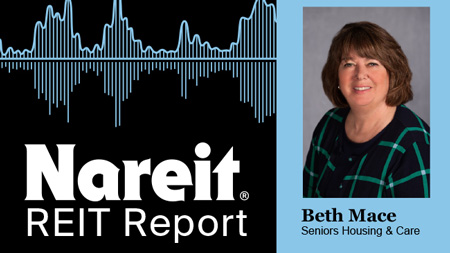 In the latest edition of the Nareit REIT Report podcast, Beth Burnham Mace, chief economist and director of outreach at the National Investment Center for Seniors Housing & Care (NIC), looked at the latest trends and developments in the senior housing sector.
In the latest edition of the Nareit REIT Report podcast, Beth Burnham Mace, chief economist and director of outreach at the National Investment Center for Seniors Housing & Care (NIC), looked at the latest trends and developments in the senior housing sector.
Mace described today’s typical senior housing resident as 83 years old with higher acuity needs than in the past. “Because of the great recession, people delayed the timing of when they moved into senior housing, and that has held to be true even today.”
Occupancy trends have been “relatively weak,” Mace said. In the third quarter, the senior housing occupancy rate was 88%, up from 87.7% in the second quarter—which was the lowest level in eight years. Net absorption of senior housing units in the third quarter was the highest number in a single quarter since NIC began recording data in 2006.
Assisted living occupancy in the third quarter moved off its record low level seen over the prior three quarters to hit 85.4%. Independent living occupancy, meanwhile, was 90.2% in the third quarter.
Overall, “demand has been strong, it just hasn’t been strong enough,” given the addition of new supply into the market, Mace said.
During the third quarter, the highest level of construction activity was underway in New York, followed by Dallas, Atlanta, Phoenix, and Houston. This contributed to downward pressure on occupancy in some of these markets, according to Mace.
Meanwhile, Mace described investor interest in the sector as “strong,” with growing interest from private equity debt funds, institutional investors, and life insurance companies. Interest from foreign capital, however, is still fairly limited, she said.
Mace also discussed recent research supported by NIC that looked at making senior housing more accessible for middle-income seniors. Middle-income seniors will make up about 43% of all seniors by 2029, the report said.
“Going forward, we’re going to need innovative financial structures and operating models to be able to provide the care and health options for America’s middle-income cohort,” Mace said.